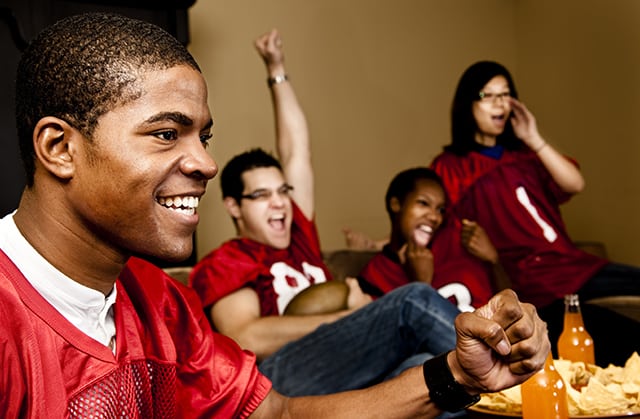What’s So Super About the Super Bowl?
Everyone knows what a bowl of soup or ice cream is. And in your home country, you might enjoy a bowl of congee or dhokla. But what does everyone on campus mean by a “Super Bowl”?
The Super Bowl is the final game of the U.S. professional football season. Every year in early February, the two best professional football teams compete while more than a third of all Americans watches on television. The 2017 Super Bowl drew an audience of 111 million people, making the game once again the most-watched TV event in the United States.
For at least two weeks before the big game takes place, students are making plans for the event. Where will they go to watch the Super Bowl? What food will they bring? What team will they support? Is there a Super Bowl pool (where people guess the score/winner of the match) they should join? Interestingly, this game is an event that the whole country knows is happening. On TV news programs there are stories about players’ volunteer work, their connections to the local area, and, of course, talk about the game itself, the commercials, and the halftime musical show. Each year, even the mayors of the two teams’ cities will place friendly, sometimes very unusual, bets on which team wins.
Why this game?
Since 1972, American football has consistently ranked as the most popular spectator sport in the country. And beginning with the first Super Bowl in 1967, U.S. fans of all kinds have watched this one game. Yet for many international students in the United States, the Super Bowl is the first American professional football game they watch.
The game itself sets the winners of the two football conferences in the National Football League (NFL): American Football Conference and National Football Conference. The two teams battle through a 16-game regular season and then two to three weeks of playoffs before winning their way to the Super Bowl.
In this year’s big game, Tom Brady, quarterback for the New England Patriots, will be playing to win his sixth Super Bowl title, an all-time record. The Patriots will be playing the Philadelphia Eagles, a team that has yet to win the Super Bowl.
Yet over the past half century, one thing has drawn many non-football fans to watch: the commercials.
Really, the ads?
Yes, the ads. With more eyes watching this game than any other TV show each year, advertisers see their best opportunity to demonstrate their products to a wide audience. Super Bowl TV ads can cost more than $5 million for 30 secondsof air time. International students in the United States who take part in Super Bowl parties are routinely amazed at what they see. Ranjit Timilshina, a University of Findlay M.B.A. student from Nepal, comments that he “remembers the ads more than the game because of the amount they invested on advertisements.”
Recent surveys show that 78% of people see the ads as entertainment, with almost a quarter saying the ads are the most important part of the Super Bowl. Pranali Athalye, an Indian graduate student from Mumbai studying health care management at the University of Findlay, agrees. Her favorite part of the event involved analyzing the ads with her friends: “Some were quite quirky, some made me reflect about deep societal issues.” By the end of the game, however, the ads became “a distraction” according to Pranali.
What about the Super Bowl halftime show?
The list of musicians who have performed during the Super Bowl, particularly since Super Bowl XXV, represents a who’s who of popular music over the last 50 years. From Madonna, Michael Jackson, Paul McCartney, the Rolling Stones, the Who, Bruce Springsteen, and Stevie Wonder, to current stars Katy Perry, Bruno Mars, and Beyonce, they have all graced the Super Bowl stage. Part of this year’s halftime show will be Justin Timberlake, his third time performing (2001 with NSync, 2004 with Janet Jackson).
While some of the musical acts that have performed may not be known to overseas students, the break from a very unusual game for some more familiar entertainment is typically welcomed. “In all honesty,” says Ranjit, he enjoyed the halftime show because he “was able to understand most of it.” On the other hand, Pranali did not enjoy the musical acts as they were not to her taste.
Get connected on campus
Being a part of a Super Bowl party on college campuses is a great cultural experience for international students. Check in with the international student office to see whether it has a “Prepare for the Super Bowl” session in the days before the game to help learn the rules of football. International student groups may also have specific events on Super Bowl Sunday. More commonly, colleges have viewing parties at the student union building where you can see the game and take part in the fun with a large group of fellow students.
Students living on campus in residence halls may find groups of students having mini-parties and watching the game in TV lounges. Talk to the resident advisors to see what they have planned. For those 21 years and older, going with a group of friends to a local sports bar provides a true taste of how many people in the United States love this event.
Most important, the Super Bowl brings people together from all walks of life and from around the world. As Ranjit recalled when he talked to his American friends before the game, “They were very excited and told me there would be lots of food.” In the end, Super Bowl Sunday gives overseas students opportunities to have fun and to broaden their circle of friends among U.S. classmates.
Be sure to follow @USNewsGlobalEd on Twitter.
Follow @usnewsglobaled
